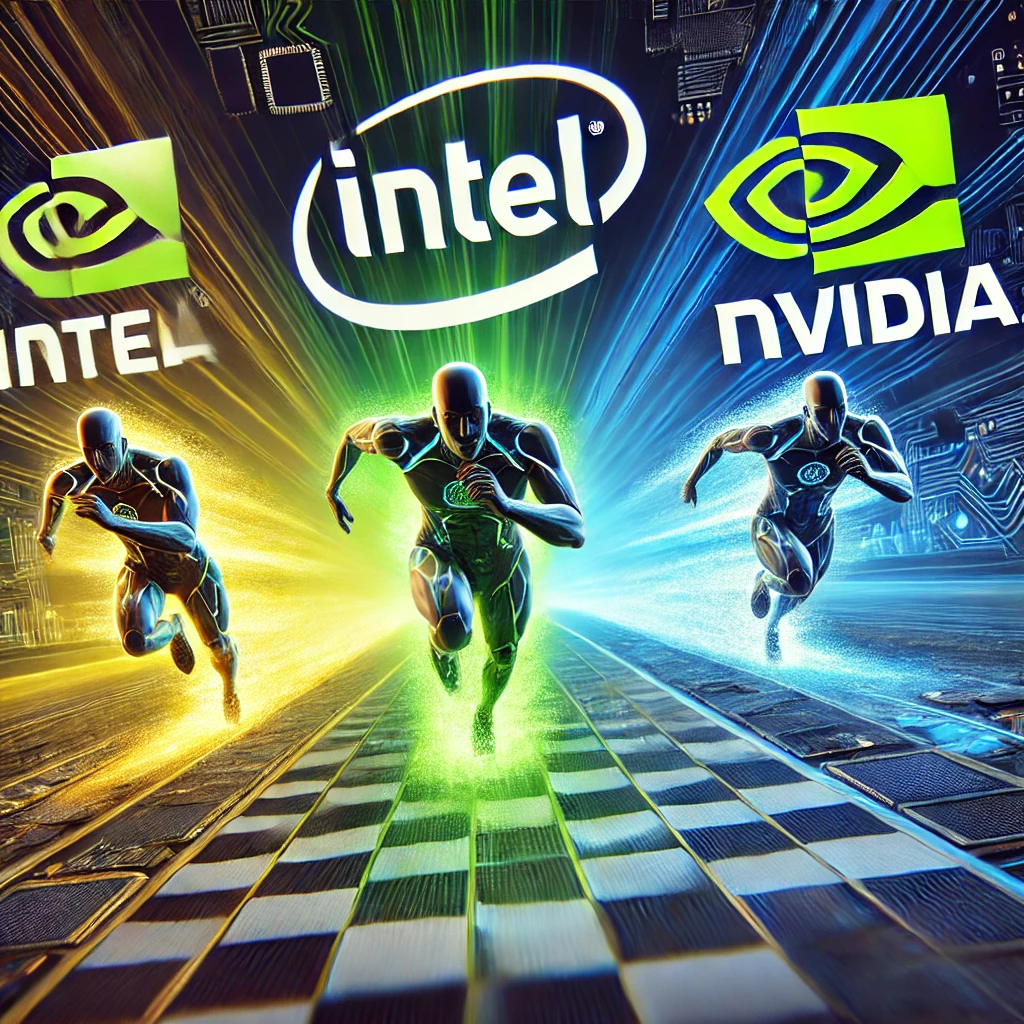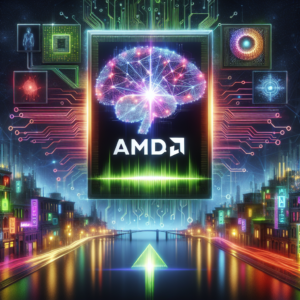Intel Falls Behind in AI Race: Nvidia and AMD Surge Ahead

The Changing Landscape of AI Technology
Artificial Intelligence (AI) has transcended from a niche field into the core of modern technological advancements. AI is revolutionizing various industries such as healthcare, finance, transportation, and entertainment. At the heart of this revolution lies the hardware designed to power AI models, including processors and accelerators that perform complex computations.
In 2024, Nvidia and AMD have risen to prominence as leaders in AI hardware, while Intel, once a dominant player, is now struggling to maintain its place in the competitive AI space. Nvidia’s dominance in Graphics Processing Units (GPUs) and AMD’s innovative computing solutions have left Intel scrambling to catch up, particularly in the growing demand for specialized AI hardware. This article will explore why Intel is falling behind, examine the rise of Nvidia and AMD, and analyze what Intel can do to reclaim its position in this crucial race.
Intel’s Decline in AI: Key Challenges
Intel’s position in the AI hardware market has been on a steady decline, with the company facing several barriers that have prevented it from capitalizing on the AI boom. From manufacturing delays to poor strategic decisions, Intel’s once-dominant position in the chip industry has been challenged by competitors that have adapted more rapidly to the demands of AI.
1. Manufacturing Delays and Process Roadblocks
Intel’s traditional strength in the semiconductor industry has been its ability to manufacture cutting-edge processors. However, in recent years, the company has struggled with delays in its manufacturing process. Intel was once known for its ability to transition quickly from one generation of chips to the next, but with its 10nm and 7nm chips falling behind schedule, competitors have gained a significant advantage.
In particular, the 7nm process, which was initially set for release in 2021, did not arrive until mid-2023. This delay set Intel back, allowing rivals like Taiwan Semiconductor Manufacturing Company (TSMC) and Samsung to forge ahead in chip production. While TSMC and Samsung rapidly embraced the shift toward 5nm and 3nm nodes, Intel’s manufacturing process remained stuck in the past.
For the AI market, which requires extremely powerful processors to handle complex computations, these delays have been particularly damaging. AI workloads demand powerful chips that can perform parallel processing tasks across thousands of cores simultaneously. Without the advanced chip architectures to support these tasks, Intel is at a significant disadvantage.
2. Lack of Specialized AI Hardware
While Intel has long been a leader in general-purpose processors with its Xeon and Core chips, its hardware portfolio for AI workloads remains underdeveloped. Intel’s Neural Network Processors (NNP), designed specifically for AI, have failed to gain traction in the market compared to Nvidia’s and AMD’s specialized offerings.
Nvidia has long dominated AI accelerators, primarily through its GPUs. The A100 Tensor Core and the more recent H100 Tensor Core GPUs are widely considered the gold standard in AI computing. These GPUs are purpose-built to handle AI workloads, including deep learning, machine learning, and natural language processing, and they excel at parallel processing tasks. Nvidia’s CUDA programming model and deep learning libraries provide an ecosystem that encourages developers to embrace its hardware, further cementing its leadership.
In contrast, Intel’s NNPs lack the same level of integration and developer ecosystem. Although Intel’s chips are capable of supporting AI workloads, they fall short of providing the same level of performance or efficiency. Intel’s attempt to break into the AI market with its Xe and Xeon chips has been undermined by their inability to match the raw power and speed offered by Nvidia’s GPUs.
3. Strategic Shifts and Leadership Issues
Intel’s struggles with AI also stem from a series of strategic missteps and leadership changes that have weakened its focus on the most pressing technologies of the future. Over the past few years, Intel has undergone several changes in leadership, leading to inconsistencies in its strategy. The company has made several shifts in its business model, each of which has been met with challenges.
Under former CEO Brian Krzanich, Intel sought to expand into mobile chips but was later forced to retreat from this market as competitors like Qualcomm and Apple surpassed it. More recently, Intel’s attempts to expand into the AI market, through acquisitions like Habana Labs and its push to develop AI chips, have not seen the same success.
Intel’s shift away from AI-centered innovations in favor of broader diversification strategies has left it vulnerable in the AI race, especially as competitors like Nvidia and AMD have honed in on delivering more specialized products for AI-specific tasks.
Nvidia’s Dominance: Leading the Charge in AI
Nvidia has solidified its position as the undisputed leader in AI hardware, thanks to its relentless innovation in GPUs and its deep investment in AI-specific technologies. While Nvidia initially gained fame for its gaming GPUs, the company quickly recognized the potential of GPUs for AI applications, and its strategy has paid off immensely.
1. GPU Innovation for AI Workloads
The shift from CPUs to GPUs for AI tasks has been one of the most significant technological trends in recent years. GPUs excel at parallel processing, allowing them to handle the massive computations required by deep learning models. Nvidia’s GPUs, particularly the A100 and H100 Tensor Core GPUs, are optimized for these tasks, offering substantial performance improvements over traditional CPUs.
Nvidia’s success in the AI market can be attributed to its focus on developing GPUs specifically for AI workloads. The A100 and H100 chips are designed to accelerate AI training and inference, making them indispensable for AI researchers and data centers. Additionally, Nvidia’s CUDA programming framework allows developers to harness the full potential of its GPUs, making them a go-to option for building AI models.
Nvidia’s GPUs have become so ubiquitous in AI development that they are found in nearly every AI research facility, supercomputing center, and data center around the world. As AI models become larger and more complex, the demand for Nvidia’s GPUs is only increasing.
2. Software and Ecosystem Leadership
Beyond hardware, Nvidia has also built an extensive software ecosystem that supports the growth of AI. The company’s CUDA platform, libraries, and AI frameworks have become industry standards. These tools make it easier for developers to create, train, and deploy AI models, thus driving further adoption of Nvidia’s GPUs.
Nvidia’s deep learning libraries, such as cuDNN and TensorRT, are integral to AI development. The company has also integrated AI capabilities into its hardware for industries like healthcare, autonomous vehicles, and robotics. Nvidia’s ability to provide a complete AI solution, from hardware to software, has made it the leader in the AI space.
3. Data Center and Supercomputing Expansion
Nvidia’s data center business has been a critical driver of its growth in the AI sector. The company’s GPUs are used in the largest supercomputers around the world, powering everything from AI research to natural disaster simulations. Nvidia’s GPUs are also central to cloud computing platforms, providing the computational resources necessary for AI companies to scale their operations.
In 2024, Nvidia continues to build on its data center leadership, working with top-tier cloud providers such as Amazon Web Services (AWS), Microsoft Azure, and Google Cloud. This expansion has helped Nvidia’s revenue soar, and its stronghold in the AI race looks increasingly secure.
AMD: Rising as a Competitive Force in AI
While Nvidia has firmly established itself as the leader in AI, AMD has quietly emerged as a rising competitor. AMD, known for its high-performance CPUs and GPUs, has gained traction in AI hardware by offering competitive alternatives to both Intel and Nvidia.
1. AMD’s EPYC Processors for AI Workloads
AMD’s EPYC processors have been making waves in the AI and data center markets. The company’s processors deliver impressive multi-core performance, which is essential for AI workloads. The EPYC chips are especially attractive for enterprises looking for powerful, cost-effective solutions to support their AI infrastructure.
The EPYC chips have become a viable alternative to Intel’s Xeon processors, which have long dominated the server market. AMD has been able to deliver high-performance solutions at a lower price point, making it an attractive option for companies looking to build or upgrade their AI infrastructure.
Additionally, AMD’s GPUs, built on the RDNA 2 and RDNA 3 architectures, offer solid performance for AI applications. While Nvidia still leads in GPU performance, AMD’s GPUs are increasingly being seen as a strong contender for AI tasks, especially for those who need cost-effective solutions.
2. Strategic Acquisitions and Partnerships
AMD’s acquisition of Xilinx, a leader in field-programmable gate arrays (FPGAs), has further strengthened its position in AI. FPGAs are used in specialized AI applications, providing custom hardware acceleration for tasks like real-time data processing. This acquisition gives AMD a significant advantage in providing tailored solutions for AI companies and research institutions.
AMD’s expanding presence in the AI market is also a result of its growing list of partnerships. The company is working with cloud providers and enterprises to integrate its hardware into AI infrastructure, further positioning itself as a serious competitor to both Intel and Nvidia.
Can Intel Catch Up? The Road to Recovery
While Intel faces significant challenges in the AI race, it is not without hope. The company has a wealth of resources, a strong R&D division, and a history of innovation. If Intel can realign its focus on AI and expedite its chip development process, it could still play a key role in the future of AI hardware.
1. Future AI Innovations
Intel is not sitting idle as it works to regain lost ground in AI. The company has launched the Gaudi and Gaudi2 AI processors, which are designed specifically for AI training workloads. These processors are aimed at data centers, offering powerful performance at competitive prices.
Intel is also investing in AI research and development, seeking to create custom silicon solutions for specific AI tasks. By embracing specialized AI hardware, Intel may be able to carve out a niche for itself in the AI market.
2. Strategic Partnerships and Acquisitions
Intel’s strategy moving forward may involve partnerships with cloud providers, AI research institutions, and tech companies. Intel has already made significant strides with its Habana Labs acquisition, which focuses on AI accelerators. By continuing to invest in AI-focused acquisitions and collaborations, Intel could strengthen its position in this critical market.
The Competitive AI Landscape
Intel is undoubtedly facing an uphill battle in the AI space, with Nvidia and AMD currently leading the charge. Nvidia’s dominance in GPUs, combined with its software ecosystem, has made it a favorite among AI developers and researchers. Meanwhile, AMD’s strong entry into the AI market, bolstered by its EPYC processors and GPU offerings, has created a competitive alternative to Intel’s hardware.
Visit our other website: aibrainpowered.com





